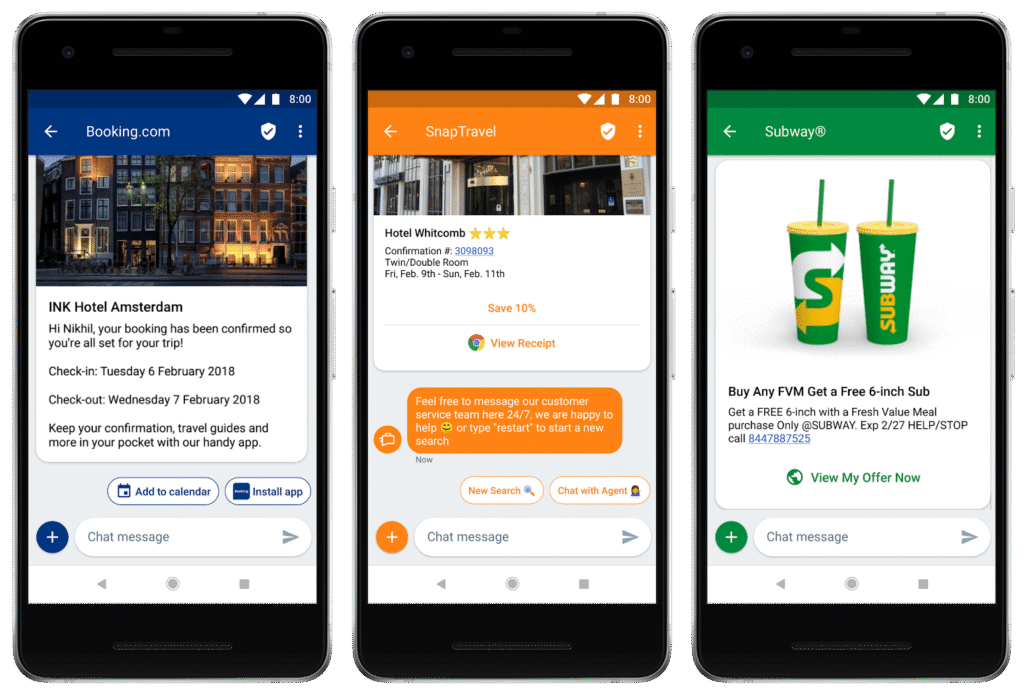Rich Communication Services or RCS messaging modernizes mobile communication. It lets businesses send interactive messages that are complete with images, buttons and branded designs, through the messaging apps people already use.
There’s no need for app downloads and that means everything works over Wi-Fi or mobile data.
This protocol is fast becoming the modern backbone of business messaging. Backed by over 1.5 billion monthly users and projected to exceed $13.1 billion in global market value by 2035, RCS messaging is on track to replace traditional SMS as the standard for customer communication.
RCS delivers more than text. Brands can send:
- High-resolution images and videos
- Interactive carousels
- Smart reply buttons
- Verified, branded sender profiles
ALL without asking users to install a separate app.
Customers expect smarter communication, period. Three out of four prefer brands that use modern technology, and 68% say convenience shapes what they buy.
RCS delivers both. It brings SMS’s reach and modern messaging’s functionality into one frictionless, built-in channel. For brands focused on performance, this is the new standard.
What Is RCS Messaging?
RCS messaging is a modern messaging protocol developed by the Global System for Mobile Communications Association (GSMA) that upgrades traditional SMS with interactive features, rich media, and verified branding, without leaving the default messaging app. Unlike SMS, it runs on IP networks (4G, 5G, Wi-Fi), which allows for higher functionality without needing a separate app.

Source: CB Insights
It retains SMS’s universal accessibility, but with capabilities that of rival platforms like WhatsApp and iMessage. When RCS isn’t supported on a device, messages automatically fall back to SMS, ensuring delivery is never compromised. This fallback mechanism makes RCS one of the few messaging formats that blends modern features with legacy reliability.
With Android commanding over 70% of global mobile market share, and Apple gradually opening RCS support, the channel’s scale is accelerating fast. For businesses, it offers a reliable, direct and interactive way to communicate with the majority of smartphone users worldwide.
How RCS Messaging Works?
RCS messaging runs on IP networks rather than the legacy circuit-switched infrastructure used by SMS.
Moreover, the protocol is powered by the IP Multimedia Subsystem (IMS), a 3GPP framework designed to support rich multimedia services across mobile networks. It uses Session Initiation Protocol (SIP) to establish communication sessions and Message Session Relay Protocol (MSRP) to handle the delivery of text, media and data.
You might wonder about the entire process of messaging at this point. So here it is as follows.
How Message Delivery Flows
Here’s what happens when an RCS message is sent:
- Sender Verification – The carrier authenticates the business or user before initiating the session.
- Session Setup – SIP creates a secure communication session between sender and recipient.
- Content Handling – The message content that can be anything from text, images is encrypted and optimized.
- Routing – Messages are routed via the most efficient path, that is, either through Google’s Jibe platform or direct carrier connections.
- Fallback Logic – If the recipient’s device or network doesn’t support RCS, the message converts to SMS or MMS automatically.
Types of RCS Messages
RCS messaging supports multiple formats, each built for different levels of interaction, branding and user experience. Choosing the right message type depends on your communication goal. Let’s discuss what we mean by that.
1. Plain RCS Messages
These are text-first messages with light branding enhancements. Think of them as SMS, upgraded:
- 2000-character text limit
- Verified sender name and logo
- Delivery and read receipts
- Auto-generated URL previews
Useful for updates, confirmations and time-sensitive alerts where rich media isn’t essential BUT brand trust still matters.
2. Rich Card RCS Message
This is the most widely used format in RCS for business. It’s built to engage:
- Up to 2,000 characters of text
- High-resolution images and videos (up to 10MB)
- Add an image or video for product display
- Quick-reply buttons and CTAs
- Location sharing and dynamic maps

Source: Techalpha Group RCS
Ideal for promotions, product launches, booking confirmations, or feedback requests—anywhere multimedia and interaction matter.
3. Carousel RCS Card
Carousel RCS Cards let brands send multiple interactive messages in one swipeable interface, combining images, text, and CTAs for app-like engagement.
These enable dynamic, two-way messaging within a 24-hour rolling window and deliver chat-style experiences with:
- Continuous exchanges across active sessions
- Real-time indicators like typing and read receipts
- Bot-ready design for AI-powered conversations
- Context memory to retain preferences across interactions

Source: Google Developers – RCS for Business documentation on Rich Cards.
This format works best for customer service, appointment scheduling or personalized assistance, you know, where continuity drives value.
Benefits of RCS Messaging
RCS messaging delivers measurable performance gains. They can be better engagement, richer interactions and higher conversion rates.
Enhanced User Experience
RCS blends SMS’s reach with the depth of modern messaging, with messages clocking in at 40-50%.
Techalpha’s platform strengthens this further with real-time analytics, fallback delivery, and rich content engagement tracking built into the portal.
In fact, RCS messages are cited to be 35× more likely to be read than email, and users are reported to spend up to 45 seconds engaging with the content.
Built into the phone’s default messaging app, RCS offers typing indicators, read receipts, carousels and interactive buttons. I mean these are literally the hallmarks of modern chat, which are now wired into business messaging.
Verified Business Communication
RCS doesn’t leave trust to chance. Verified business messages come stamped with carrier-authenticated logos, names, and branding, all embedded directly into the conversation thread. Spoofing? Off the table.

Source: Techalpha Group RCS
It’s part of a broader fraud-prevention layer, where carriers verify senders before delivery, giving businesses especially in banking, healthcare, and e-commerce, a trusted pipeline to the user’s phone.
Superior Engagement Metrics
The numbers are where RCS pulls ahead. Interactive messages drive 4x higher engagement than SMS and campaigns routinely hit conversion rates up to 50%. In terms of ROI, some businesses have reported a 1633% increase over standard messaging methods.
Built-in analytics complete the loop. Businesses can track delivery status, read receipts, button clicks and more.
Does RCS Messaging Use Data?
Yes, RCS uses data (Wi-Fi or mobile data) to send messages, similar to internet-based messaging apps like WhatsApp or iMessage.
RCS messages are sent over a Wi-Fi or mobile data connection, similar to other internet-based messaging apps. They do not use the traditional cellular network used for standard SMS messages.
Here’s how data usage works:
- Wi-Fi Connection: When using RCS over an active Wi-Fi network, there is typically no additional cost, similar to using apps like WhatsApp or iMessage.
- Mobile Data: If you are not connected to Wi-Fi, RCS uses your mobile data plan. Any costs incurred would be based on your specific carrier data plan rates.
Fallback to SMS: If you don’t have an active data connection (either Wi-Fi or mobile data), or if the recipient does not support RCS, the message can be automatically sent as a traditional SMS or MMS message. Standard SMS messages use the cellular network and do not count against your data plan, but they may have per-message costs depending on your plan.
How Techalpha Can Help You with RCS Messaging
Techalpha is India’s go-to CPaaS (Communication Platform as a Service) provider for brands that want RCS messaging done right.
From infrastructure to delivery, compliance to performance, we offer a full-stack solution designed to give businesses total control over every aspect of their RCS messaging strategy.
Purpose-Built RCS Infrastructure
Our dedicated RCS portal gives businesses a clean, unified interface to build, deploy and monitor campaigns at scale. The Lounge Page dashboard is the nerve center. It features DLT configuration, automatic SMS fallback for non-RCS devices and real-time analytics. If a recipient’s phone or carrier doesn’t support RCS, fallback ensures your message still lands.
RCS Template Creation — Simplified
We’ve automated the RCS template approval process with direct carrier integration (Vodafone Idea) and built-in support for every RCS format:
- Plain Text Messages
- Rich Card Messages
- Carousel Messages
Templates are submitted via a clear Excel-based workflow covering every detail from image orientation to CTA logic. What would take days is now streamlined to minutes.
Campaigns That Launch Themselves
Techalpha’s GUI lets marketers run complex campaigns without needing to speak fluent tech:
- Choose transactional or promotional sender IDs
- Use pre-approved templates or create new ones
- Support for vertical and horizontal carousels
- Add images (up to 5MB) and videos (up to 10MB)
- Integrate URLs for dynamic media rendering
- Upload customer lists with column mapping
- Set it and forget it with real-time or scheduled deployments
Every feature is designed to remove blockers between message design and message delivery.
Performance Metrics That Actually Mean Something
Our platform breaks RCS down:
- Total campaigns sent
- Message attempt and delivery outcomes
- Read receipts and click-throughs
- Failed/dropped message diagnostics
- Date-range filters and exportable reports
- Visual dashboards with traffic trend charts across all engagement stages
You don’t need an analyst to interpret your performance. It’s all there and it’s actionable.
Carrier Partnerships That Matter
Our exclusive integration with Vodafone Idea (VI) means:
- Verified business sender badges
- Carrier-grade delivery priority
- Encryption and fraud prevention baked in
- Total compliance with Indian telecom regulations
- Direct access to technical teams for support and troubleshooting
This is RCS backed by infrastructure, not hope. Whether you’re exploring RCS for the first time or scaling an enterprise messaging strategy, Techalpha gives you the infrastructure, intelligence, and support to run RCS like a pro.




